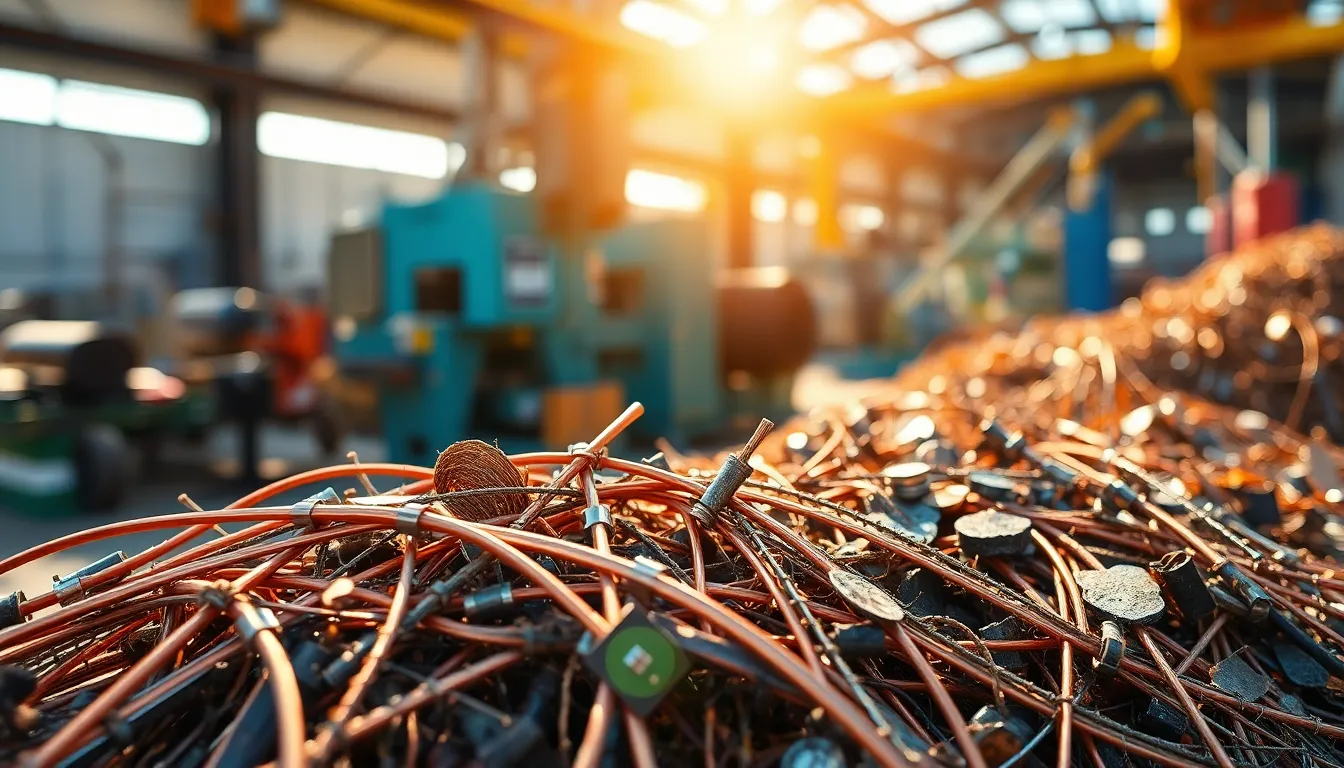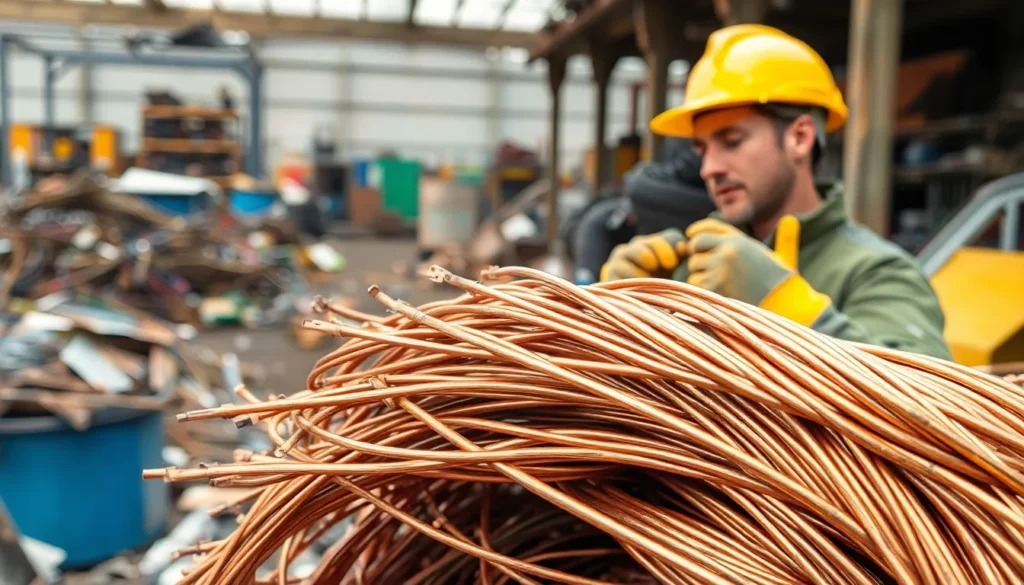Table of Contents
ToggleCopper’s not just for plumbing and electrical wiring anymore; it’s the golden child of the scrap metal world. As the demand for this versatile metal skyrockets, so do the questions about its future price. Will it be a wild ride or a smooth sail? Investors, recyclers, and DIY enthusiasts alike are on the edge of their seats, eager to know if their scrap copper stash will make them rich or just keep their wallets moderately happy.
Understanding Scrap Copper Prices
Understanding scrap copper prices involves recognizing various market influences and historical trends. As interest in copper grows, so does the need for insight into its pricing dynamics.
Factors Influencing Scrap Copper Prices
Market demand plays a critical role in scrap copper pricing. Emerging technologies, especially in renewable energy and electric vehicles, drive the need for copper. Supply fluctuations also impact prices; disruptions in mining or recycling processes can lead to short-term spikes. Additionally, economic conditions, such as inflation or global trade policies, can alter market stability. Finally, competition from alternative materials affects copper’s desirability across industries.
Historical Price Trends
Historical trends reveal significant fluctuations in scrap copper prices over the last two decades. From 2003 to 2008, prices surged, reaching about $4 per pound due to increased demand from China. After a downturn during the financial crisis, prices stabilized around $3 per pound until 2017. Recent years have shown volatility, driven by supply chain issues and the COVID-19 pandemic, causing spikes above $4 per pound again. Consistent analysis of these trends aids recyclers and investors in making informed decisions regarding scrap copper investments.
Future Scrap Copper Price Predictions

The future of scrap copper prices remains uncertain yet promising, with many factors at play. Understanding the market dynamics is essential for stakeholders in the industry.
Market Analysis
Market analysis indicates that the ongoing surge in demand for copper from industries such as renewable energy and electric vehicles will persist. Risk factors include economic fluctuations, which can create significant price volatility. Data shows that global supply disruptions and increased recycling efforts also influence market prices. Recent statistics illustrate that scrap copper prices reached around $4.50 per pound in early 2023, but projections suggest prices could stabilize between $3.75 and $5.00 per pound through 2025. Monitoring these trends allows recyclers and investors to make informed decisions about timing and inventory management.
Expert Opinions
Expert opinions frequently highlight the critical role of technological advancements in influencing future scrap copper prices. Analysts predict that increased investment in renewable energy will drive demand, maintaining upward pressure on prices. Furthermore, they emphasize that geopolitical tensions and changes in trade policies may impact supply chains, creating additional uncertainty. Some experts point to historical price movements as indicators of future trends, suggesting that the long-term outlook for scrap copper remains positive despite short-term fluctuations. Predictions from industry leaders commonly estimate a price range of $4.00 to $6.00 per pound in the next few years, reinforcing the need for continuous market evaluation.
Impact of Global Events on Copper Prices
Global events significantly influence copper prices, impacting future scrap copper forecasting. Understanding these influences helps investors and recyclers navigate market uncertainties.
Economic Factors
Economic growth directly affects copper demand, with increased industrial activity leading to higher consumption. In 2023, many experts noted that robust economic recovery from the COVID-19 pandemic increased copper usage across various sectors. Inflation rates also play a pivotal role, where rising costs can squeeze margins for consumers and businesses alike. Supply chain disruptions create scarcity, driving prices higher, particularly as global economies stabilize. Predictions indicate that continued global industrialization, especially in developing nations, may keep copper prices buoyant in the medium term.
Environmental Regulations
Environmental regulations increasingly shape the scrap copper market. Governments worldwide implement stricter policies to promote sustainable practices, influencing demand patterns. Regulation on raw material extraction can limit supply, boosting the value of recycled copper. In 2022, initiatives promoting electric vehicles and renewable energy sources enhanced copper’s role in environmentally friendly technologies. Market players anticipate that future regulations focused on reducing carbon footprints will further increase the demand for recycled copper. Collectively, these environmental measures are expected to keep copper prices in flux, potentially elevating scrap metal value over time.
Strategies for Investors
Investors should consider various strategies when navigating the scrap copper market. Understanding the key dynamics between short-term and long-term investments provides valuable insight for strategic decision-making.
Short-Term vs Long-Term Investment
Short-term investments in scrap copper may capitalize on price volatility. For instance, monitoring market trends can lead to timely buying and selling, especially during periods of high demand. Longer-term investments allow investors to benefit from sustained growth driven by emerging technologies, such as electric vehicles and renewable energy. Evaluating historical price trends reveals potential for consistent gains over time. Investors often evaluate macroeconomic factors, such as inflation and global recovery, assessing their impact on future price stability. Ultimately, choosing between short-term gains and long-term growth requires careful consideration of individual investment goals.
Diversifying Copper Investments
Diversifying copper investments helps mitigate risks associated with market fluctuations. By spreading investments across different forms of copper, such as scrap metal, copper futures, and mining stocks, one can balance potential returns. For example, engaging in both physical scrap purchases and financial instruments allows investors to leverage various market segments. Investors also find value in considering geographic diversification, investing in different regions with varying mining and recycling capacities. This approach reduces dependency on any single market dynamic. Moreover, including other metals, such as aluminum and nickel, in the portfolio enhances overall resilience against market changes. Adopting a diversified strategy positions investors to maximize opportunities while minimizing exposure to potential downturns.
The future of scrap copper prices appears to be shaped by a blend of demand from innovative industries and economic factors. As the world increasingly turns to renewable energy and electric vehicles the need for copper will likely remain strong. While fluctuations are inevitable due to market dynamics and geopolitical tensions the overall outlook seems positive.
Investors and recyclers should stay informed about emerging trends and be prepared for potential volatility. By adopting strategic approaches and diversifying their investments they can navigate the complexities of the scrap copper market effectively. With careful planning and awareness of market influences it’s possible to maximize returns in this evolving landscape.








